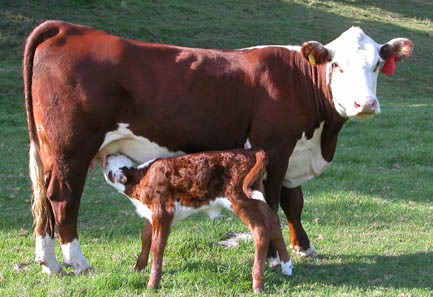Consuming countless vitamins,
nutrients, and up to 10 billion live immune cells a day, there's no
denying it: breastfed babies, of any mammalian species, get some of
the most incredible nutrition around. But could it be that gender of
your infant determines how much milk they're getting? In a recent
study, published on PLOS One, on female lactating cows by Katie Hinde
and several of her associates, it's been shown that the sex of the
fetus, as well as other factors in utero, plays a large part in how
much milk the mother produces for her young, as well as how much milk
the mother will produce for any future pregnancies.
After studying over 2.39 million
lactation records from 1.49 million dairy cows, it's been shown that
heifers who, during their first pregnancy, gave birth to a daughter
produced 1.6 percent more milk than they would have for a son.
Interestingly enough, this bump up in production from the first
female pregnancy was maintained for any future pregnancies, but the
heifers who first gave birth to a son did not receive as high of a
raise in milk production. Because on the dairy farms the female
calves are taken away from their mothers soon after birth, it was
noted that the overall boost in milk production must have come while
the calf was in utero.
Other studies have shown that
human mothers, in a similar sense, also produce more milk for their
first born daughters than their sons. One reason for this could be
the hormone estrogen, which is more abundant in the female fetus as
well as the mother and could correlate to the boost in milk
production. There are also many other physiological and hormonal
factors that are involved in the production and nutrient content of
breast milk, including the mother's gut bacteria and environmental
exposure to pollution or toxins. Studies have shown that milk
produced for a week old female newborn can be much different, in
terms of nutrient and bacterial content as well as hormonal levels,
than the breast milk produced for a ten month old male baby. It all
depends on the individual needs and demands of the child in question.
Overall, the more time passes
the more we realize that the differences between other species and
ourselves, especially concerning our young, really aren't as glaring
as we once thought. Being one of the most universal forms of
nutrition, breast feeding has proven itself again and again to be
incredibly adaptive and specific to the mother and child, whether
they are human or not. The amazing specifications of breast milk will
continue to be explored and studied as scientists yearn to understand
the subtle physiological intricacies and factors that are involved in
producing the most ancient life giving substance there is.

No comments:
Post a Comment